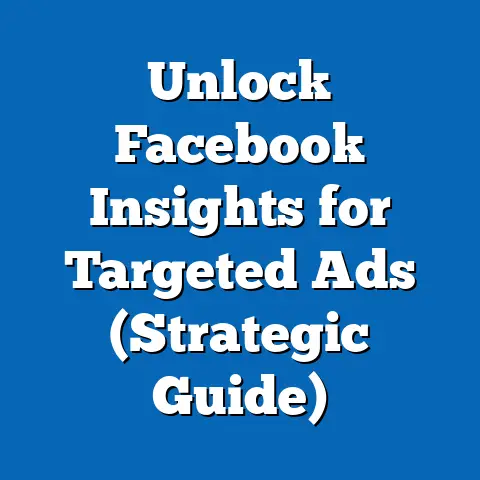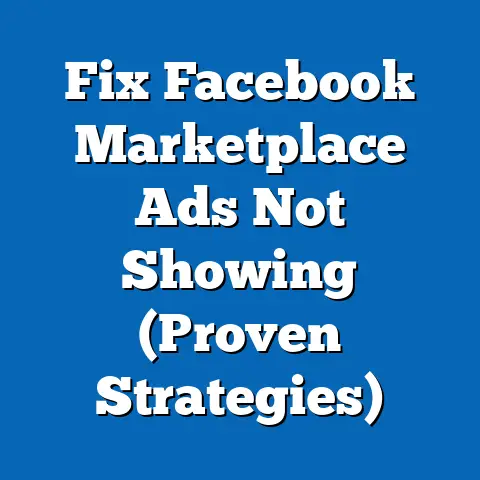Facebook Ad Image Specs: Maximize Engagement (Expert Guide)
Facebook advertising remains one of the most powerful tools for businesses seeking to reach targeted audiences, with global ad revenue reaching $114.9 billion in 2022, according to Statista. Investment in Facebook ads has surged over the past decade, driven by the platform’s unparalleled user base of 2.96 billion monthly active users (MAUs) as of Q3 2023. A critical component of ad success lies in visual content, particularly image specifications, which can significantly impact engagement rates—often by as much as 2.3 times compared to text-only posts, per Hootsuite’s 2023 Social Media Report.
Investment in Facebook Advertising: Statistical Trends and Insights
Overall Investment Growth
Facebook’s parent company, Meta, reported that advertising revenue accounted for 97.5% of its total revenue in 2022, highlighting the platform’s dominance in the digital ad space. Global spending on Facebook ads grew by 19% year-over-year between 2021 and 2022, despite economic uncertainties and privacy policy changes like Apple’s iOS 14.5 update, which impacted ad tracking. According to eMarketer, businesses worldwide are projected to spend $137.2 billion on Facebook ads by 2024, reflecting a compound annual growth rate (CAGR) of 9.4% from 2020 to 2024.
This growth is fueled by the platform’s ability to deliver precise targeting options and high return on ad spend (ROAS). For instance, a 2023 study by WordStream found that the average ROAS for Facebook ads across industries is 10.68, meaning businesses earn $10.68 for every $1 spent. However, the effectiveness of these investments often hinges on creative elements, particularly image quality and adherence to platform specifications.
Demographic Breakdown of Ad Investment
Investment in Facebook ads varies significantly across demographics, reflecting differences in user behavior and purchasing power. According to Pew Research Center’s 2023 data, 70% of U.S. adults aged 18-29 use Facebook, compared to 65% of those aged 30-49 and 50% of those aged 50-64. Businesses targeting younger demographics (18-29) allocate approximately 35% of their social media ad budgets to Facebook, per a 2022 survey by Sprout Social, due to higher engagement rates in this group—often 3-4% compared to 1-2% for older cohorts.
Gender also plays a role in ad investment strategies. Women, who make up 54% of Facebook’s U.S. user base, are more likely to engage with visual content, with a 2023 study by Socialbakers showing 12% higher click-through rates (CTR) on image-based ads among women compared to men. As a result, industries like fashion and beauty, which target female audiences, account for 22% of total ad spend on the platform, per eMarketer’s 2022 industry report.
Geographically, North America remains the largest market for Facebook ad investment, contributing 42% of global ad revenue in 2022, followed by Europe at 25% and Asia-Pacific at 21%. Small and medium-sized businesses (SMBs) in emerging markets like India and Brazil are increasing their ad spend by 15-20% annually, driven by growing internet penetration and mobile usage, according to Meta’s 2023 SMB report.
Historical Comparisons: Ad Spending Over Time
Comparing current investment trends with historical data reveals the rapid evolution of Facebook advertising. In 2012, global ad revenue for Facebook was just $4.3 billion, a fraction of the $114.9 billion reported in 2022. This represents a staggering 2,574% increase over a decade, driven by the platform’s expanding user base and improved ad targeting capabilities.
In the early 2010s, ad formats were primarily text-based or simple banner ads, with image specs playing a minor role. Engagement rates averaged 0.5-1%, per a 2013 study by AdRoll. By contrast, the introduction of visually rich formats like carousel ads and video content in the late 2010s boosted average engagement rates to 3.6% by 2020, according to Hootsuite. This shift underscores the growing importance of image specifications, as poorly optimized visuals can reduce CTR by up to 30%, per a 2022 report by HubSpot.
Cost-per-click (CPC) has also risen over time, reflecting increased competition. In 2015, the average CPC on Facebook was $0.27, compared to $0.97 in 2022, a 259% increase, per WordStream data. This trend highlights the need for businesses to optimize ad creatives, particularly images, to ensure cost efficiency.
Future Projections for Facebook Ad Investment
Looking ahead, investment in Facebook advertising is expected to maintain steady growth, though at a slightly slower pace due to market saturation and competition from platforms like TikTok and Instagram. eMarketer projects global ad spend on Facebook to reach $158.6 billion by 2026, with a CAGR of 7.8% from 2023 to 2026. Emerging markets will drive much of this growth, with ad spend in Asia-Pacific expected to increase by 12% annually through 2026.
Technological advancements, such as augmented reality (AR) ads and AI-driven creative optimization, are also likely to shape future investment. A 2023 report by Gartner predicts that 60% of businesses will incorporate AI tools for ad creation by 2025, potentially reducing costs and improving image relevance. However, privacy regulations like the General Data Protection Regulation (GDPR) and California Consumer Privacy Act (CCPA) may pose challenges, with 45% of marketers citing data restrictions as a barrier to effective targeting, per a 2023 survey by Forrester.
Optimizing Facebook Ad Image Specs for Maximum Engagement
Having established the scale and importance of investment in Facebook advertising, we now turn to the practical aspects of creating high-performing ads through optimized image specifications. Visual content is the cornerstone of engagement on social platforms, and adhering to Facebook’s guidelines while incorporating best practices can significantly boost campaign performance.
Understanding Facebook Ad Image Specifications
Facebook provides specific guidelines for image dimensions and formats across various ad types to ensure optimal display on desktop and mobile devices. For single image ads, the recommended aspect ratio is 1.91:1 to 1:1, with a minimum resolution of 1080 x 1080 pixels for square formats and 1200 x 628 pixels for landscape formats, per Meta’s 2023 Ad Manager Guide. Images should not exceed 20% text coverage to avoid reduced delivery, a rule enforced by Facebook’s Text Overlay Tool.
For carousel ads, which allow multiple images in a single ad unit, each image should maintain a 1:1 aspect ratio with a resolution of at least 1080 x 1080 pixels. Video thumbnails and Stories ads have unique specs—Stories, for instance, require a 9:16 vertical format with a resolution of 1080 x 1920 pixels. Failure to meet these specs can result in cropped images or reduced visibility, leading to a 25% drop in engagement, according to a 2022 study by Buffer.
File size and format are equally critical. Images should be under 30 MB and saved as JPEG or PNG files for optimal loading times. Slow-loading ads can increase bounce rates by 40%, per Google’s 2021 user experience report, emphasizing the need for lightweight, high-quality visuals.
Why Image Specs Matter: Impact on Engagement
Adhering to image specifications directly correlates with engagement metrics like CTR, conversion rates, and overall campaign success. A 2023 analysis by Socialbakers found that ads with properly optimized images achieve 37% higher CTR compared to those with distorted or low-resolution visuals. This is particularly important on mobile devices, which account for 98.5% of Facebook’s ad impressions, per Meta’s Q3 2023 earnings report.
Image content also plays a role beyond mere dimensions. Ads featuring human faces or emotional storytelling generate 23% more engagement than generic product shots, according to a 2022 study by Hootsuite. Bright, high-contrast colors can further increase visibility by 18%, per a report from Canva’s design team, illustrating the interplay between technical specs and creative choices.
Demographic Preferences in Visual Content
Different demographics respond to visual content in unique ways, necessitating tailored image strategies. Younger users (18-24) prefer bold, trendy visuals with vibrant colors, with 45% more likely to engage with ads featuring user-generated content (UGC), per a 2023 Sprout Social survey. In contrast, users aged 35-54 are 30% more likely to click on ads with professional, polished imagery, such as product close-ups or infographics, according to Socialbakers data.
Gender differences also influence visual preferences. Men are 15% more likely to engage with ads showcasing action-oriented imagery, such as sports or technology, while women show a 20% higher engagement rate with lifestyle or community-focused visuals, per a 2022 report by HubSpot. Businesses targeting specific demographics should align image content with these preferences while maintaining platform specs to maximize impact.
Historical Evolution of Image Specs and Engagement
Facebook’s image specifications have evolved significantly since the platform’s early ad offerings. In 2010, ads were limited to small thumbnail images (100 x 72 pixels) with minimal creative flexibility, resulting in low engagement rates of 0.1-0.2%, per a 2011 study by AdParlor. By 2015, the introduction of larger image formats and mobile-optimized specs boosted average engagement to 2.5%, according to Hootsuite’s historical data.
The shift to mobile-first advertising in the late 2010s further refined image specs, with vertical formats like Stories gaining prominence. Today, Stories ads achieve an average CTR of 0.86%, compared to 0.58% for traditional News Feed ads, per a 2023 report by WordStream. This historical progression underscores the importance of staying updated on spec changes to maintain competitive performance.
Best Practices for Optimizing Images Beyond Specs
While adhering to technical specifications is essential, additional strategies can enhance engagement. First, use A/B testing to compare different image styles and layouts—businesses that test at least two variations report a 28% increase in CTR, per a 2022 study by Optimizely. Second, incorporate clear calls-to-action (CTAs) within the image design, as ads with visible CTAs see 14% higher conversion rates, according to HubSpot.
Third, prioritize mobile optimization beyond basic specs. Images should be designed with smaller screens in mind, using large text and minimal clutter—mobile-optimized ads achieve 32% higher engagement, per Google’s 2021 mobile marketing report. Finally, leverage analytics tools like Facebook Ads Manager to track image performance metrics and refine strategies over time.
Tools and Resources for Image Creation
Several tools can assist in creating spec-compliant, high-quality images for Facebook ads. Canva offers pre-sized templates for various ad formats, ensuring compliance with aspect ratios and resolutions. Adobe Photoshop and Lightroom provide advanced editing capabilities for professional-grade visuals, while free tools like GIMP cater to budget-conscious marketers.
For text overlay compliance, Meta’s Text Overlay Tool allows users to check if their images exceed the 20% text limit before uploading. Additionally, platforms like Crello and Snappa provide drag-and-drop interfaces with built-in Facebook ad templates, streamlining the design process for non-designers.
Statistical Comparisons Across Ad Types and Demographics
Engagement by Ad Type and Image Format
Different ad types yield varying engagement levels based on image optimization. Single image ads, the most common format, achieve an average CTR of 0.9%, with properly spec’d images boosting this to 1.2%, per WordStream’s 2023 data. Carousel ads, which feature multiple images, outperform single images with a CTR of 1.8%, provided each image adheres to the 1:1 aspect ratio and high-resolution standards.
Stories ads, optimized for vertical 9:16 formats, see the highest engagement among younger demographics, with a CTR of 1.5% for users aged 18-24 compared to 0.7% for users over 35, per Socialbakers 2023 data. Video ads, while not the focus of this article, often rely on compelling thumbnail images to drive initial clicks, with optimized thumbnails increasing play rates by 30%, according to Meta’s creative best practices.
Cost and Performance Across Demographics
Ad performance and cost also vary by demographic targeting. Ads targeting users aged 18-24 have a lower average CPC of $0.85 compared to $1.10 for users aged 35-54, reflecting higher competition for older, higher-income audiences, per WordStream 2023 data. However, younger users require more frequent creative refreshes, as ad fatigue sets in 20% faster among this group, according to a 2022 HubSpot study.
Geographic targeting impacts costs as well. In the U.S., the average CPC is $1.01, compared to $0.42 in India, per eMarketer’s 2023 global ad cost report. Businesses must balance cost considerations with image quality to ensure effective targeting across regions.
Future Projections for Image Specs and Engagement Strategies
Looking forward, Facebook’s image specifications are likely to evolve with advancements in display technology and user behavior. By 2025, 80% of ad impressions are expected to occur on mobile devices with high-resolution screens, necessitating even sharper image requirements, per a 2023 forecast by Gartner. Vertical formats like Stories are projected to dominate, with ad spend on this format expected to grow by 25% annually through 2027, according to eMarketer.
AI-driven design tools will also shape the future of ad imagery. Meta is already testing AI features to suggest optimal image compositions, with early adopters reporting a 15% uplift in engagement, per a 2023 TechCrunch report. Businesses that adopt these technologies while staying compliant with evolving specs will likely maintain a competitive edge.
Finally, user privacy concerns may influence image content strategies. With increasing restrictions on data collection, contextual targeting—relying on image relevance rather than personal data—could become critical. A 2023 Forrester report predicts that 70% of marketers will shift toward contextual ad strategies by 2026, emphasizing the need for visually compelling, spec-compliant content.
Conclusion
Investment in Facebook advertising continues to grow, with global ad spend reaching $114.9 billion in 2022 and projected to hit $158.6 billion by 2026. The success of these investments hinges on creative elements, particularly image specifications, which can boost engagement by 37% when optimized correctly. By understanding platform guidelines, demographic preferences, and historical trends, businesses can craft visually compelling ads that drive higher CTR and ROAS.
As the digital ad landscape evolves, staying ahead of spec changes and leveraging emerging tools like AI will be essential. Whether targeting younger mobile-savvy users or older professional demographics, the principles of high-quality, spec-compliant imagery remain universal. With strategic planning and continuous optimization, marketers can maximize engagement and ensure their Facebook ad investments yield sustainable returns.






